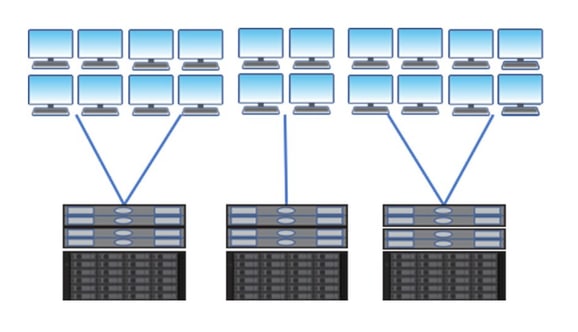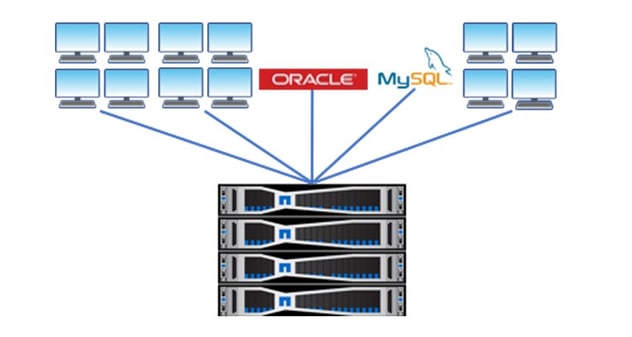The Evolution of VDI


Kendall Carroll
For the past decade, as organizations have been rethinking their approach to delivering desktops to end users, many have turned to a virtual desktop infrastructure (VDI) environment. An initial driver to VDI was the focus on reducing the per-desktop cost. Along with lower cost, IT teams also had to make sure that end users didn’t experience performance impacts as a result of the move from physical to virtual desktops. This tension between cost and performance was one of the more difficult challenges in delivering effective VDI platforms to users.
Delivering Desktops to End Users with NetApp HCI
Enter NetApp® HCI, the enterprise-scale hybrid cloud infrastructure solution designed to support the consolidation of mixed workloads. At the heart of NetApp HCI is the NetApp Element® software, designed to protect workloads from interfering with each other and to deliver predictable performance to every application.
Let’s take a close look at how NetApp HCI addresses the challenges of delivering VDI to end users. Because of the huge variety of application workloads in an organization, IT teams often find the requirements to support end users to be chaotic and unpredictable. Every end user has their own usage pattern, and those patterns may conflict. To deal with the unpredictable resource contention for the different types of users, IT teams had to isolate the VDI from other IT resources. Each desktop type had to be built using its own infrastructure “pod” to deliver the hardware required to drive the desktop. Isolating each user type to its own physical architecture helped to ensure that performance of the VDI environment remained consistent. This model provided slightly more consistent workload performance, and it also limited the scope of failures across groups of end users.
To make sure that these isolated pods were built to support the chaos of targeted end-user workloads, assessment tools were developed to help design and size VDI environments. These tools were used to estimate the CPU, RAM, IOPS, capacity, graphics, and network required to support the number of concurrent users and application types. By using these tools, each new pod could be created to support a specific set of user requirements within a reasonable range of outcomes. The result, as shown in the following figure, was a proliferation of pod-based systems across all the user types, just to support the VDI effort.
 VDI pods[/caption]
VDI pods[/caption]
Addressing the Future with End-User Computing
As VDI evolves, end-user apps and end-user data (files) need to become more accessible. Accessibility is accomplished through a virtual workspace, enhancing VDI to EUC (end-user computing). An emerging trend is to collapse VDI silos to run as just another workload in a truly software-defined data center. EUC buyers are looking for infrastructure beyond just hardware convergence. They want fully programmable and massively simplified infrastructure to build apps and virtual machines, and to offer consumption of IT to all modes of operations. Adoption of hyperconverged infrastructure (HCI) is increasing, for both the hybrid cloud and EUC, because of its ability to deliver resources as simply as possible.
 End-user computing on hyperconverged infrastructure[/caption]
End-user computing on hyperconverged infrastructure[/caption]
Looking back at the evolution of VDI and the pod-based architecture, it’s clear that end-user workloads are unpredictable at best, and the challenge of consolidating the desktop varieties in a single platform often leads to resource contention. Why should we expect this constraint to change, especially when adding even more business applications to the mix? Isn’t the idea of putting all the different desktops plus databases and business applications on a single platform just a recipe for disaster?
Unlike other solutions, NetApp HCI allows multiple mission-critical workloads to share the same infrastructure as the virtual desktop without affecting the end-user experience. The user experience is protected with predictable performance, avoiding the painful slowdowns that are common with conventional infrastructure. By discretely assigning storage IOPS with storage capacity, each virtual machine can be assured that the storage won’t slow it down. And with the storage performance discretely “assigned” to a VM, the storage won’t be impacted by another VM trying to use the same storage resource. Each application gets the compute and storage performance it needs, and those resources won’t be “taken” by another application. Mixed EUC workloads can be easily consolidated on a single NetApp HCI system.
Modern operating systems and other EUC applications like Microsoft Office are increasingly graphic intensive, which adds CPU cycles to virtual desktops and applications, reducing user density on host servers. Solving this problem, the NetApp HCI H610C is a 2U compute node with two NVIDIA Tesla M10 graphics adaptors for greater user density of task and for knowledge workers who use graphics-intensive media. With this capability, end users have a better experience and user density can be increased.
NetApp HCI is also fully integrated to deliver a VMware Private Cloud experience, provisioned within just minutes out of the box. It’s built on the foundation of the Element software, so users experience all that has thrilled EUC buyers previously: QoS, flexibility and scale, and overall simplicity.
Gone are the silos. Gone are scale limitations. EUC can leverage desktops, databases, and other workloads with full confidence. Simple, globally efficient resources are available today with NetApp HCI. For more information, visit the NetApp EUC page and create tomorrow’s end-user computing environment today.
Kendall Carroll
Kendall is a Product Marketing Manager at NetApp. A theatre teacher turned MBA, Kendall gets to combine her passion for storytelling and business acumen in her marketing role. Find Kendall exploring Colorado with her family or cooking her way through Mary Berry's Baking Bible.